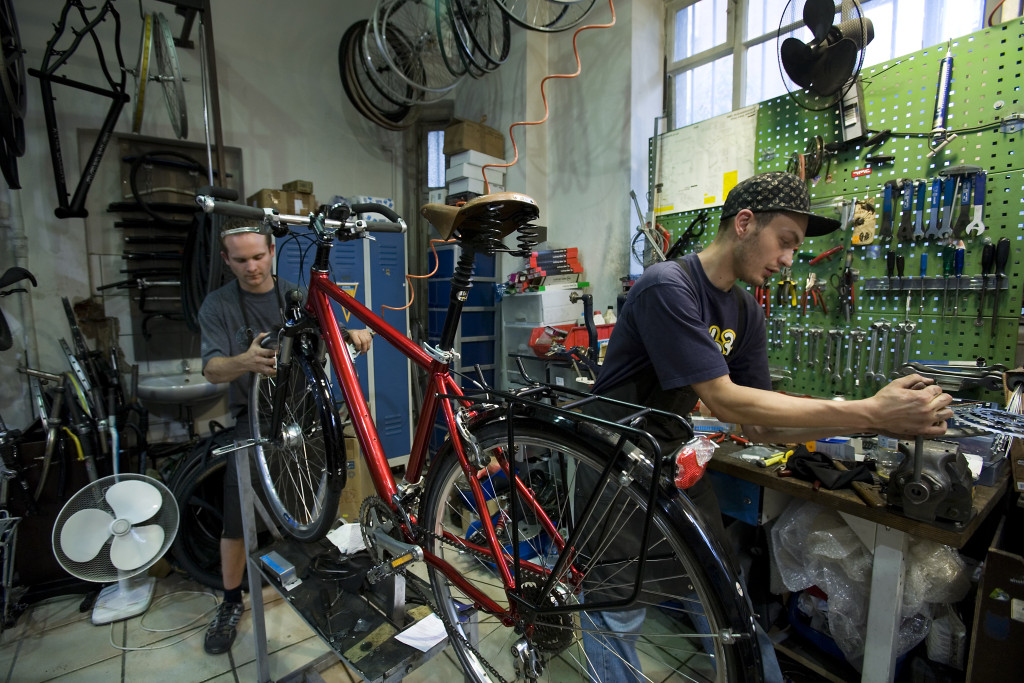After spending a chilly winter off the open road, both you and your bike probably need some TLC before being road ready. Here are the steps that we recommend to getting back in the saddle without any issues (besides huffing and puffing through your first ride).
**If you are not sure of how to correctly tune or repair a bike, please take it to your local bike shop. This guide is not a substitute to proper professional maintenance.**
1. Clean your bike
First of all, remember that cleaning certain portions of your bike too thoroughly (such as the chain or chain ring) can be harmful. This could remove helpful lubrication that helps your bike function smoothly. I prefer to use a simple microfiber towel and a non-abrasive cleaner like Simple Green.
Simply spray the cloth with the cleaner until it is damp and wipe the surfaces of the bike to remove dirt and grime. Try not to use any water since that can cause the metal pieces of the bike to corrode. Once you have finished removing any dirt, I suggest wiping the entire bike with a clean cloth to remove any extra cleaner left behind.
2. Inspect you brakes
Having brakes that work well is extremely important. Controlling your speed helps you keep better control over your bike and avoid accidents. There are three parts that make up your braking system and we will check all of them.
- Pads – these are the rubber or ceramic pieces that touch the rim of the wheel when you squeeze the brake lever. Look at all the pads to see if they are wearing evenly. If they are not, or if they are worn through, consider replacing them
- Levers – make sure your bike is adjusted so that you can easily reach the brake levers. Also, test both the front and rear brake levers to be sure that they are working correctly
- Cables – If your brakes seem loose or they are unresponsive, you can make small adjustments by tightening the cables from the lever to the brake. (How to do this varies between different bike models)
3. Check your wheels
You wouldn’t go very far without wheels on your bike. And if your wheels aren’t in good shape, you won’t get much farther. You can check if your wheels are straight or ‘true’ by turning the bike over and resting it on the saddle and the bars. spin each wheel, standing in line with it to see if it is spinning perfectly straight.
Check for loose spokes which may mean that your wheel is warped or damaged.
Finally, check the rim for dents, cracks, or rough edges that could damage the brake pads.
4. Test the drivetrain
This is the part of your bike that will wear out most quickly and needs the most attention. Not only does it need the most attention, but it is also the most complex. The drivetrain is made up of the pedals, chain, chain ring, cassette and derailleur. You can detect most problems with a simple test.
With your bike still flipped over, turn the pedals with one hand while you shift through all of the gears with the other. If it shifts through smoothly, you should be good to go. Take one last look to make sure there are no teeth missing from the chain ring or cassette.
If you find any problems with the drivetrain and you are not familiar with the skills or tools needed to fix it, take it to a bike shop to have it repaired. If done wrong, repairs can make things worse and be very dangerous.
5. Inspect the tires
Check your tires by looking at them and rubbing your fingers along them to find any cracking or splitting. You can pump your tires up to the correct pressure (usually listed on the sidewall of the tire itself) and leave it for a period of time to see if there are any air leaks. Tires are fairly cheap and should be replaced regularly.
6. Check the cables
There are probably two sets of cables on your bike; (1) a set connecting the brake levers to the brakes and (2) a set connecting the shifters to the derailleurs. Check these cables for dirt, grit, and general wear and tear. Having the cable tuned can increase your bike’s performance and ensure your safety while riding. If you find any wear or the cables are loose, have a bike technician repair or replace the cables for you. Cables should be replaced every 2-4 years.
7. Apply lubricant
I favor grease over oil because last longer and does not dry out as quickly. You can apply grease to all moving parts (be sure to avoid the rims and brake pads). Apply grease to the chain while slowly turning the pedals so that you get an even layer.
8. Evaluate yourself
Check yourself and know your abilities. Don’t push yourself to extremes when you are not yet ready or in shape. Design a training program and make sure you know how to handle the bike you are riding. Finally, have fun and be safe. Always wear a helmet and take the proper safety precautions, including signaling to cars and other cyclist. Know the laws you are expected to follow, be courteous, and share the road.
Image Credit: Jorge Royan via http://commons.wikimedia.org/

